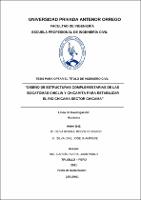Diseño de estructuras complementarias de las bocatomas chiclin y chicamita para estabilizar el rio chicama sector chicama

View/
Download
(application/pdf: 6.457Mb)
(application/pdf: 6.457Mb)
Date
2021Author(s)
Oliva Rivera, Rodolfo Junior
Silva Diaz, José Jhampiere
Metadata
Show full item recordAbstract
La presente tesis tiene como finalidad el diseño de las estructuras complementarias
de las bocatomas Chiclín y Chicamita para estabilizar el cauce del río Chicama en
el sector Chicama para ello se realizó un levantamiento topográfico con estación y
drone, obteniendo como resultados pendientes de 0.58 %, 0.73%, 0.84%, 0.59% a
lo largo del trazo del eje principal del cauce del río Chicama (2.58 km), teniendo en
cuenta el criterio que no se generen movimientos de tierra (corte y relleno)
considerables.
Para el diseño de las bocatomas Chicamita y Chiclin se pudo inferir que sólo se
puede diseñar la bocatoma Chicamita esto debido a la poca distancia (200m) que
hay con la bocatoma Chiclin ya que el remanso que produciría el barraje fijo de esta
bocatoma aguas arriba afectaría a la bocatoma Chicamita.
Se realizó el estudio de hidrología, para hallar el caudal promedio del río el cual fue
de 250 m³/s, los caudales máximos recurrentes de 400 m³/s y 600 m³/s, y para
hallar el caudal de diseño de la bocatoma Chicamita el cual fue de 1400 m³/s para
un periodo de retorno de 100 años.
Para el diseño hidráulico de la bocatoma Chicamita, las dimensiones de las
estructuras complementarias que obtuvieron fueron las siguientes: la longitud del
barraje fijo de 200m, la altura del barraje fijo de 2.10 m, la longitud del barraje móvil
18m, longitud de la poza disipadora de 15m, ancho de las 2 compuertas del barraje
móvil de 5m cada una, ancho de la compuerta del canal de limpia de 3m, altura de
los muros de encauzamiento de 4.96m. Sin embargo con este diseño propuesto,
no se logró estabilizar el cauce del río Chicama, debido a que la longitud del barraje
fijo era demasiado grande (200m) pasando por esta estructura la mayoría del
caudal, causando velocidades demasiadas altas a la salida de lo poza disipadora.
Se realizó un nuevo diseño de la bocatoma Chicamita cuyas dimensiones fueron:
longitud del barraje fijo de 100m y longitud de barraje móvil de 100m, con este
diseño se demostró que el cauce se estabiliza debido a que las velocidades a la
salida de la poza disipadora son bajas tanto para un caudal promedio (Qp= 250
m³/s) incluso para caudales máximo recurrentes como 400 m³/s. Al tener
velocidades bajas , no habrá mucha socavación por ende el cauce se mantendrá
estable. The purpose of this thesis is to design the complementary structures of the Chiclín
and Chicamita intakes to stabilize the channel of the Chicama River in the Chicama
sector, for which a topographic survey was carried out with a station and drone,
obtaining pending results of 0.58%, 0.73 %, 0.84%, 0.59% along the main axis of
the Chicama riverbed (2.58 km), taking into account the criterion that no significant
earth movements (cut and fill) are generated.
For the design of the Chicamita and Chiclin intakes it could be inferred that only the
Chicamita intake can be designed due to the short distance (200m) that there is with
the Chiclin intake and that the backwater that would produce the fixed bar of this
intake upstream would affect to the Chicamita intake.
The hydrology study was carried out to find the average flow of the river which was
250 m³ / s, the maximum recurrent flows of 400 m³ / s and 600 m³ / s, and to find
the design flow of the Chicamita intake which it was 1400 m³ / s for a return period
of 100 years.
For the hydraulic design of the Chicamita intake, the dimensions of the
complementary structures that were obtained were the following: the length of the
fixed bar of 200m, the height of the fixed bar of 2.10 m, the length of the mobile bar
18m, length of the dissipating pool 15m, width of the 2 gates of the mobile bar of 5m
each, width of the gate of the cleaning channel of 3m, height of the channeling walls
of 4.96m. However, with this proposed design, it was not possible to stabilize the
channel of the Chicama River, because the length of the fixed bar was too long
(200m) passing through this structure most of the flow, causing too high speeds at
the outlet of the pool. dissipative.
A new design of the Chicamita intake was made whose dimensions were: length of
the fixed bar of 100m and length of mobile bar of 100m, with this design it was shown
that the channel is stabilized due to the fact that the speeds at the exit of the
dissipating pool are low both for an average flow (Qp = 250 m³ / s) even for recurring
maximum flows such as 400 m³ / s. By having low speeds, there will not be much
scour, therefore the channel will remain stable.
Subject
Collections
- Ingeniería Civil [1260]

